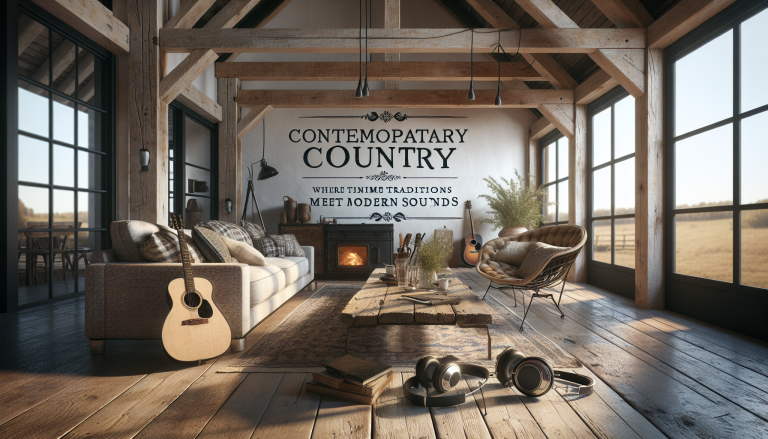The Roots of Contemporary Country: Bridging Tradition and Modernity
Country music, a heartstring-tugging emblem of American music, has constantly evolved while steadfastly embracing its rich roots. Among its many branches, contemporary country stands out as a luminous thread weaving the past’s soulful narratives with today’s vibrant sounds. Emerging as a powerful genre in the late 20th century, contemporary country has breathed new life into the beloved traditions of country music, capturing both the spirit of the American heartland and the pulse of modern life.
The story begins in the decades following World War II, a time when country music was transitioning from regional folk tunes to something resembling a commercial force. While classic artists like Hank Williams and Patsy Cline laid the foundations with storytelling that reflected the hardships and hopes of everyday Americans, the arrival of contemporary country in the 1980s and ’90s introduced an exciting blend of traditional instruments and fresh, pop-influenced melodies. This intersection reflects a cultural shift: country music reaching broader audiences without abandoning the deeply held values of sincerity and emotional honesty.
Genre Description: Where Tradition Meets Today
Contemporary country retains the unmistakable sound of classic country—the gentle twang of the steel guitar, the warm embrace of acoustic guitars, and the storytelling lyricism that conveys raw, heartfelt emotions. Yet, it adds layers of polish in production, often drawing from pop, rock, and even R&B influences to create songs that are radio-friendly and irresistibly catchy. This genre lives in the tension between honoring heritage and embracing innovation.
What makes contemporary country compelling is its ability to speak to new generations while echoing the experiences of those before them. Themes of love, loss, family, small-town life, and personal triumph remain central, but the narratives often resonate with today’s complexities—urban experiences, modern relationships, and evolving social dynamics. It’s music that feels both familiar and fresh, a testament to its artists’ skill at telling timeless stories through a modern lens.

Shaping the Sound: Key Artists and Groups
No discussion of contemporary country would be complete without mentioning the luminaries who have shaped its development. Garth Brooks, the genre’s trailblazing icon of the ’90s, shattered records and perceptions by incorporating stadium-rock showmanship while remaining true to country storytelling. His albums like *No Fences* and *Ropin’ the Wind* are woven with unforgettable anthems such as “Friends in Low Places,” a song that has become a communal cheer of camaraderie and defiance.
Another pivotal figure is Shania Twain, whose album *Come On Over* stands as one of the best-selling country albums worldwide. Her vibrant sound, blending country twang with pop hooks, opened doors for countless crossover artists. Twain’s music transcended boundaries, inviting new listeners into the fold without compromising the spirited essence of country music.
In more recent years, artists like Carrie Underwood, Keith Urban, and Luke Bryan have continued this legacy, each bringing a distinctive voice and fresh perspective. Carrie Underwood’s powerful vocals and emotionally charged performances, Luke Bryan’s relatable storytelling, and Keith Urban’s virtuosic guitar skills have all solidified contemporary country as a genre both respected and adored. Emerging talents like Kelsea Ballerini and Maren Morris further enrich the genre, their songwriting reflecting the evolving lives of women with authenticity and grace.
Notable Songs and Albums: Defining Moments in Contemporary Country
Certain songs have taken on legendary status, serving as milestones that mark the genre’s evolution. Tracy Lawrence’s “Time Marches On” eloquently captures life’s inevitable changes with poetic precision, while Taylor Swift’s early country albums beautifully bridged the worlds of country and pop, setting the stage for a new era of genre fluidity.
Albums like *The Outsider* by country singer Todd Snider meld storytelling with social commentary, highlighting how contemporary country can be a vehicle for greater cultural reflection. Meanwhile, albums such as Chris Stapleton’s *Traveller* reminded listeners of the gritty soul at country music’s core, his raw voice and blues-infused sound proving that the genre’s emotional depth remains undiminished.
Songs like Miranda Lambert’s “The House That Built Me” embody the genre’s heart—a poignant tribute to home and memory sung with a vulnerability that stirs listeners to their core. These works demonstrate how contemporary country, while sonically diverse, remains deeply connected to its storytelling roots.
Lasting Effects: The Heartbeat of American Music
Contemporary country has permanently transformed the landscape of American music. It has made the genre accessible to a wider, international audience without sacrificing the heartfelt warmth that lies at its core. By blending traditional instrumentation with innovative production and universal themes, contemporary country has created a dialogue between generations, honoring the past while embracing the future.
This genre’s impact extends beyond radio airwaves and concert halls. It has influenced fashion, language, and American identity itself. The earnest lyrics and memorable melodies invite listeners into shared experiences—whether celebrating newfound love, mourning loss, or reflecting on the simplicity of rural life. Contemporary country reminds us that music is both a refuge and a connection, a way to tell our stories and listen to others.
In the grand tapestry of American music, contemporary country pulses with life—its twangy guitars echoing the footsteps of pioneers while its lyrics sing the dreams and struggles of a new age. As artist and storyteller Vince Gill once said, “Country music, to me, is like a big old glass of sweet tea on a hot summer’s day. It’s comforting; it’s familiar, but it can also surprise you with a little twist.” This genre, rich in tradition and brimming with innovation, continues to be that sweet tea—endlessly refreshing and deeply satisfying to the soul.